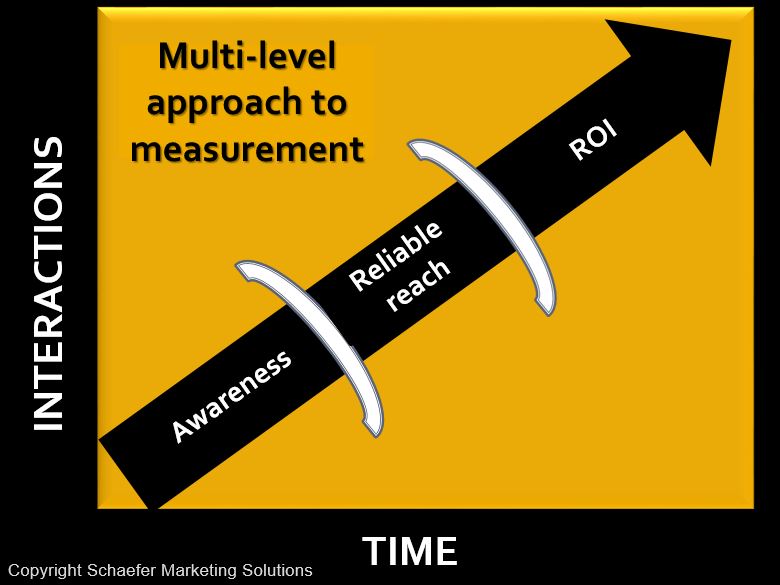
Here is a common question I hear from many of my clients and students:
"My boss is looking at the leads we generated on advertising versus social media or content marketing and is questioning why he is putting money into content instead of just doubling down on ads. How do I measure the value of what I'm doing?"
First, let’s not rule out the notion that your boss might be right! Advertising works.
Still, there is a place for social media and content marketing in most businesses so let’s tackle this question in a new and meaningful way.
What I want to propose today is that your success might not be determined by WHAT you measure but also WHEN you measure it. What you measure and how you measure it needs to be dynamic.
The engagement curve
There are many kinds of businesses and many uses for content marketing but my assumption today is that you want to connect with people in a way that eventually leads them to take some action: register, download, sign-up, purchase, etc.
To accomplish this, it takes time, patience and resources. If you are comparing your social media and content marketing efforts to traditional advertising results, it is probably the wrong comparison.
A more likely analogy is the success you might be having at a networking event or trade show. You have to show up a lot before people begin to recognize you, know you, trust you and eventually buy something. Between trade shows you might create little opportunities to connect with these contacts and let them know you’re there and you have a lot of value to provide.
Again, there are a LOT of exceptions and different ways to go with this but in general, I think this is where social media and content really fits in the marketing mix — a tool to build awareness, connections, relationships … and eventually action.
It kind of looks like this:

Isn’t this what marketing is about in one simple chart? Finding those provocations — those interactions — to drive our customers to higher and higher levels of engagement over time?
I think this is where content marketing fits precisely in your strategic mix — providing a drip, drip, drip of communication to lead people up this curve. Content is the catalyst.
As I demonstrated in a recent post, it takes time to get people up this engagement curve and realize true financial benefits from content and social media marketing. In the survey I referenced in this post, nearly every company realized a boost in awareness right away from social media marketing but many companies took five years or more before they started to see a bump in sales.
This suggests that there are different flows to the benefits of content and social media marketing, which might be visualized like this:

You can slice this up any way you like — whatever path and flow seems right for your business — but it seems to me there are three distinct phases to most marketing programs over time:
Awareness — As we get up and going, we are figuring it out, experimenting and failing, aligning with platforms and partners. Most important, the focus is on building a content-creating culture, a business oriented toward publishing and responding. This is a very difficult phase but the good news is, most companies do experience some success even in the first year.
Reliable reach — When you begin, it might feel like you are throwing your content into a vast ocean. Is anybody out there? Are they seeing anything? But after a time of creating meaningful content, connecting with an audience, and maybe even distributing some content through paid and promotional methods, something amazing happens — people begin to talk back, they subscribe, they sign up for something, maybe they even buy your product.
My friend Jay Baer characterized this phase as “reliable reach” and I like that term very much. You are building a true audience, a reliable audience. When people subscribe to your content, they are saying “Please market to me!”
ROI phase — With these building blocks in place, you are poised to begin realizing tangible financial benefits from your efforts. You are seen as a helpful and trusted authority, you are consistent, and your presence is reliable. When does this occur? For some businesses, four, five years or more.
The content marketing measurement problem
If you’re an active and experienced marketer, you probably see these waves rolling before you, although you might not have visualized it this way before.
Here’s the problem almost every organization faces — they want to know the right measure for social media success and in particular, they want to crack the ROI code and they want to do it NOW.
But as you can see, there is NO SINGLE RIGHT MEASURE because the organizational priorities mature and change over time. Your goal is not to find the right social media measure. It to find the right measures that are appropriate to your place in time.

In this illustration, I’ve provided an example of what I mean. If you are in year one of your content marketing program, “ROI” is probably not going to be the most appropriate measure for your business. The research shows it probably isn’t going to happen, so let’s table that idea, OK?
In your first phase, you are building an internal marketing competency, and the most important measures should reflect that you are having a positive impact on the company culture. You need to show that you are “doing it” through metrics such as:
- Increasing your organic audience
- Establishing a consistent and reliable publishing schedule
- Seeing a bump in web traffic as a result of your content
- Early signs of engagement like Likes and comments
- Measures that show your brand awareness is building through social media mentions
This is not a complete list, of course. These are a few measures that fit in the box on the illustration! I’m sure you can think of many more that show you are moving in the right direction.
Purists may dismiss metric like number of followers or Likes because it is not ROI, but I think these are meaningful in this phase because it demonstrates cultural change, and that is the most important thing you can accomplish at the outset.
The focus on connection
By the end of the first year of your content marketing journey, you are probably ready to change your metrics. If you’re not beating your phase one goals after 12 months of focused effort, you might need a serious course correction.
As you enter this second phase of marketing maturity, the focus needs to be on a deeper audience connection. We’re not simply building and audience, we need to be igniting our ideas through conversations and content transmission.
In this next phase, we are moving beyond “broadcasting.” There needs to be some signs that our communication is beginning to flow back to us, too.
After the first year, it is time to overhaul your metrics by focusing on:
- The number of people subscribing to your channels
- Lead generation (not just sales but also new business connections, new employees, suppliers)
- Advocacy — Are your customers sharing your content? When people share content, they are standing up in a virtual way and saying “I believe in this and so should you.” Content sharing is a very powerful indicator of success in this phase.
- Authority — It is also important to look at WHO is sharing your content. Are you beginning to reach influencers in your industry? Are people paying attention to your content who can open new doors for your business?
How long does this second phase last? This will vary a lot by industry, and specifically by the competition and information density you are up against.
The payoff
A few months ago, I received this email: “I have been reading your blog for three years and I am a fan of your podcast. I have a project for you …”
I think this is a pretty typical pattern in content marketing. It might take years to really see the pay off. Again, this is going to vary wildly by business and industry but by year three you should start to see some financial. When you feel like you have outgrown the phase two metrics, it’s time to move forward once again and change your measurement to reflect:
- Customer loyalty and retention
- Conversion rate
- SEO benefits
- Marketing cost savings and cost avoidance
- Sales
These are hard numbers that can actually be used in an ROI calculation, which is what we must all be aiming for eventually.
I hope this perspective helps. The key idea is that this is a new marketing channel works in a different way. It can’t necessarily be measured the same way as advertising but ultimately it must lead to the same financial returns.
Top illustration courtesy Flickr CC and FrankieLeon

No comments:
Post a Comment